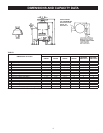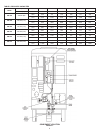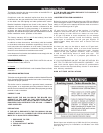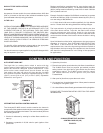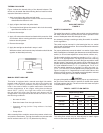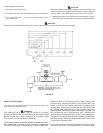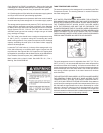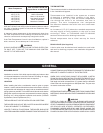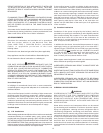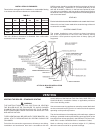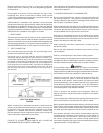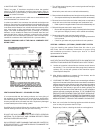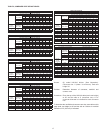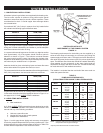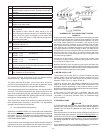
13
PERMIT OPERATION OF GAS APPLIANCES IF INSTALLED
18 INCHES OR MORE ABOVE THE FLOOR. THIS MAY
REDUCE THE RISK IF LOCATION IN SUCH AN AREA CANNOT
BE AVOIDED.
WARNING
FLAMMABLE ITEMS, PRESSURIZED CONTAINERS OR ANY
OTHER POTENTIAL FIRE HAZARDOUS ARTICLES MUST
NEVER BE PLACED ON OR ADJACENT TO THE BOILER.
OPEN CONTAINERS OF FLAMMABLE MATERIAL MUST
NOT BE STORED OR USED IN THE SAME ROOM WITH
THE BOILER.
A hot water boiler installed above radiation level or as required
by the authority having jurisdiction, must be provided with a low
water cutoff device at the time of boiler installation.
AIR REQUIREMENTS
Provisions for combustion and ventilation air in accordance
with the current edition of the National Fuel Gas
Code, ANSI Z223.1, CAN/CSA B149.1, Installation
C od e s, o r a p pl i ca b le p ro v is i o ns o f t h e l o ca l
building codes.
Provisions for vent, bleed and gas relief lines (when applicable).
Keep appliance area free of combustible or ammable liquids.
Do not obstruct the ow of combustion or ventilating air.
WARNING
FOR SAFE OPERATION PROVIDE ADEQUATE AIR FOR
COMBUSTION AND VENTILATION. AN INSUFFICIENT SUPPLY
OF AIR WILL CAUSE RECIRCULATION OF COMBUSTION
PRODUCTS RESULTING IN AIR CONTAMINATION THAT
MAY BE HAZARDOUS TO LIFE. SUCH A CONDITION OFTEN
WILL RESULT IN A YELLOW, LUMINOUS BURNER FLAME,
CAUSING CARBONING OR SOOTING OF THE COMBUSTION
CHAMBER, BURNERS AND FLUE TUBES AND CREATES A
RISK OF ASPHYXIATION.
Unconned Space
In buildings of conventional frame, brick or stone construction,
unconned spaces may provide adequate air for combustion, and
draft hood dilution.
If the unconfined space is within a building of tight construction
(buildings using the following construction: weather stripping,
heavy insulation, caulking, vapor barrier, etc.) air for combustion,
ventilation, and draft hood dilution must be obtained from
outdoors or spaces freely communicating with the outdoors. The
installation instructions for confined spaces in tightly constructed
buildings must be followed to ensure adequate air supply.
Conned Space
(a) U. S. Installations
When drawing combustion and dilution air from inside a conventionally
constructed building to a conned space, such a space shall be
provided with two permanent openings, ONE WITHIN 12 INCHES
OF THE ENCLOSURE TOP AND ONE WITHIN 12 INCHES OF THE
ENCLOSURE BOTTOM. Each opening shall have a free area of at
least one square inch per 1000 Btuh of the total input of all appliances
in the enclosure, but not less than 100 square inches.
If the confined space is within a building of tight construction,
air for combustion, ventilation, and draft hood dilution must be
obtained from outdoors. When directly communicating with the
outdoors or communicating with the outdoors through vertical
ducts, two permanent openings, located in the above manner,
shall be provided. Each opening shall have a free area of not
less than one square inch per 4000 Btuh of the total input of
all appliances in the enclosure. If horizontal ducts are used,
each opening shall have a free area of not less than one
square inch per 2000 Btuh of the total input of all appliances
in the enclosure.
(b) Canadian Installations
Ventilation of the space occupied by the boiler(s) shall be
provided by an opening for ventilation air at the highest practical
point communicating with outdoors. The total cross-sectional
area shall be at least 10% of the area of the combustion air
opening but in no case shall the cross-sectional area be less
than 10 square inches (6500 mm
2
).
In additional to the above, there shall be permanent air supply
opening(s) having a cross-sectional area of not less than 1
square inch per 7,000 BTUH (310 mm
2
/KW) up to and including
1,000,000 BTUH plus 1 square inch per 14,000 BTU in excess
of 1,000,000 BTUH. This opening(s) shall be located at, or
ducted to, a point neither more than 18" (450 mm) nor less
than 6 inches (150 mm) above the floor level.
Where power vented equipment is used in the same room as the
boiler, sufcient air openings must be supplied.
UNDERSIZED OPENINGS MAY RESULT IN INSUFFICIENT AIR
FOR COMBUSTION.
WHERE AN EXHAUST FAN IS INSTALLED IN THE SAME ROOM
WITH A BOILER, SUFFICIENT OPENINGS FOR AIR MUST BE
PROVIDED IN THE WALLS.
UNDERSIZED OPENINGS WILL CAUSE AIR TO BE DRAWN
INTO THE ROOM THROUGH THE CHIMNEY, CAUSING POOR
COMBUSTION. SOOTING MAY RESULT WITH AN INCREASED
RISK O F ASPHYXIATION.
CHEMICAL VAPOR CORROSION
WARNING
CORROSION OF THE FLUEWAYS AND VENT SYSTEM
MAY OCCUR IF AIR FOR COMBUSTION CONTAINS
C E R TA I N C H E M I C A L VA P O R S W H I C H B R E A K
DOWN INTO ACIDS AT HIGH TEMPERATURE. SUCH
CORROSION MAY RESULT IN FAILURE AND RISK OF
ASPHYXIATION.
Water boiler corrosion and component failure can be caused
by the heating and breakdown of airborne chemical vapors.
Spray can propellants, cleaning solvents, refrigerator and air
conditioning refrigerants, swimming pool chemicals, calcium
and sodium chloride, waxes, and process chemicals are typical
compounds which are corrosive. These materials are corrosive
at very low concentration levels with little or no odor to reveal
their presence. Products of this sort must not be stored near
the boiler. Also, air which is brought in contact with the water
boiler should not contain any of these chemicals. If necessary,
uncontaminated air should be obtained from remote or outside
sources.














